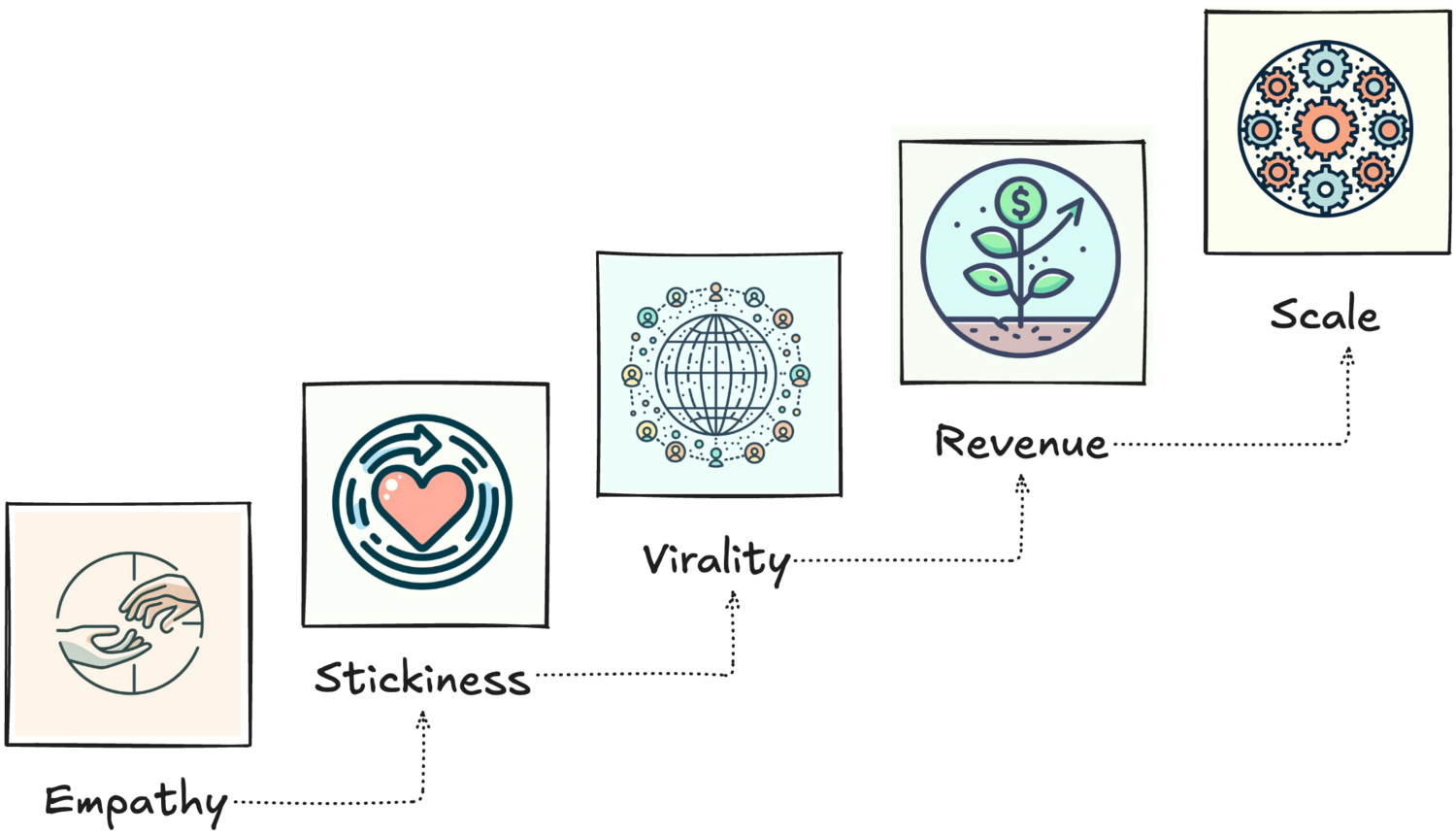Five Stages of Growth
The Five Stages of Growth model provides guidelines for focusing on a specific type of work at different times during a product lifecycle, and can be helpful to select objectives and product development ideas that could create a big impact.

Alistair Croll and Benjamin Yoskovitz introduced this model in the Lean Analytics book, based on a progression of metrics for successful software products. The model shows a sequence of risks that need to be addressed for a successful product, and suggests that the delivery teams should focus their work on addressing those risks in particular order to deliver the biggest impact. The model presents a set of stages, strongly advocating that the early stages need to be addressed before the later ones.
- Empathy: figuring out how to solve a real problem
- Stickiness: building the right product to keep users around
- Virality: growing the user base
- Revenue: establishing a sustainable, scalable business model
- Scale: consolidating the business operations
For example, this model suggests that it’s wrong to focus on revenue before we have a sticky product, or that it’s wrong to focus on reducing operational costs before the product is generating good revenue. The right option would be to focus on creating a sticky product before investing in growth, and investing in growth before focusing too on revenue.
Deriving metrics from Five Stages
In the Lean Analytics book, the authors suggest using the model to select One Metric that Matters (OMM), and to focus on improving that metric. Each stage suggests a list of potential metrics to focus on.
In the Empathy stage, products should focus on proving that they’re actually solving a problem for someone important, so the target metrics can be around behaviour changes for the intended use case (for example, make sure that people are doing something important faster, better, more easily with your product than without it). In the Stickiness stage, products need to prove that there is a potential market for solving the important problem, which usually revolves around focusing on frequency of usage and improving the product so that people continue to use it. After all, if users leave and never return after trying a product, it’s unlikely that they’ll pay for the usage. In the third stage, products should focus on proving that they can reach the target market, and the focus tends to shift to growing the user base and activities around increasing the number of potential users. In the fourth stage, products need to prove that they can sustainably extract value from customers to enable sustainability and further investment, so metrics tend to be around payments, revenue and profit. In the fifth stage, products focus on consolidating and reducing operational costs to deliver a service at scale, effectively increasing profitability.
In Lizard Optimization, Gojko Adzic proposes using the model to set both targets and constraints (or guardrail metrics). The current stage of growth becomes a source of target metrics (for example, in the Stickiness phase, a target metric can be to increase usage frequency by 20%). Other stages are useful as sources of constraint metrics (for example, the operational costs should not increase by more than 20%, or revenue should not decrease at all). Having both targets and constraints helps to prevent focus on short-term gains that would be counterproductive for further growth, to spot unintended impacts and to set the context for viability of solutions. (For example, making a commercial usage product free would would likely increase usage frequency, but it fail the constraint of retaining revenue).
When using stages of growth to derive metrics, ensure that you’re actively optimising only in one area. If you wish to optimize several areas, split the work into several phases using Christmas Prioritisation.
Using Five Stages of Growth outside of start-ups
The terminology of the Five Stages model is heavily influenced by the Lean Startup movement, but the model itself is applicable in a much wider context. For example, even with internally built enterprise products, it’s too early to focus on reducing operational costs if the users are not yet getting enough value from the product). Some stages, though, will need to be renamed or skipped in certain contexts.
- In enterprise software contexts (and generally when you are not relying on viral social media), instead of “Virality” it might be better to call the third stage “Market-share” or “Audience growth”. Using the Growth Pyramid is a potentially good way to break down this step further.
- In non-profit contexts, it might make sense to skip the fourth stage (“Revenue”) or phrase it differently around value extraction. Remember that this stage is about creating and optimising a sustainable model to capture the value from the market in the value exchange loop model, not about delivering more value the users. The previous stages should already deal with delivering value to the market.
- In contexts where the market is relatively limited and you do not expect to reach large scale, the fifth stage can be renamed “Streamlining” or “Operational control”.
Learn more about the Five Stages of Growth
- Lean Analytics: Use Data to Build a Better Startup Faster, ISBN 978-1098168186, by Alistair Croll, Benjamin Yoskovitz
- Fifty Quick Ideas To Improve Your User Stories, ISBN 978-0993088100, by Gojko Adzic, David Evans